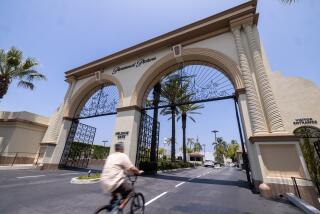SCRIPT TO SCREEN
Auguste Lumiere and his brother Lois are credited as the first to project a film to a paying audience--on Dec. 28,1895. âIt can be exploited for a certain time as a scientific curiosity, but apart from that, it has no commercial value whatsoever,â said Auguste about their combination camera / printer / projector. He obviously underestimated their achievement.
Nearly a century later, more than 300 films a year are produced in California, the average cost of making a movie is almost $30 million, and movie theater admissions are close to a billion a year.
When the credits roll, the contributions of hundreds may appear for a single film--whether the work was done on a studio backlot in the Valley, on location on a residential street in Van Nuys, or on an editing bench at a Valley post-production house.
Job titles and number of personnel vary from film to film, but the process of filmmaking shown below is typical:
(BEGIN TEXT OF INFOBOX / INFOGRAPHIC)
DEVELOPMENT
Contract is negotiated with writer, and the source, such as a novel, play or original screenplay, is converted into a workable script.
PRE-PRODUCTION
* Actors cast
* Locations scouted
* Background researched.
* Set is designed and constructed.
* Equipment, props, and costumes are rented or purchased
* Detailed production budget / shooting schedule worked up
PRODUCTION
The production of a movie can involve hundreds of behind-the-scenes personnel, specially trained people who do everything from building and painting sets to âgripsâ who transport and set up equipment, props and scenery. Some of those on the scene:
Directing Team
* Director selects and stages what will be photographed in any given take, indicating where camera will be, deciding which takes should be used. When âblockingâ a scene, the director tells a actor where to stand and when and where to move.
* Assistant directors keep production running smoothly and on schedule, breaking down script, arranging background action, managing extras.
* Script supervisor keeps track of what is being shot, making sure continuity is maintained.
*
Camera Crew
Director of photography (cinematographer) determines how set will be lit, works with director on how shots will be set up.
* Camera operator operates camera, determining for sound crew where to position boom microphones.
* Focus puller maintains camera during shooting, changing lenses and magazines and following focus.
* Clapper / loader uses clapper board, loads film into camera, labels film cans and prepares film for shipment to lab.
*
Sound crew
* Sound mixer works with director and cinematographer to decide where microphones should be placed, operates a mixing console into which microphonesâ signals are fed and balanced on their way into tape recorder.
* Boom operator handles boom microphone or fits actors with smaller mikes
* Cable handler ensures wires are properly run from mike to console or recorder
*
Electrical Crew
Gaffer works with cinematographer to set up shot, sometimes roughing out lighting plan beforehand
Best boy is second in command and assists gaffer
Key grip works partly as a construction manager and back-up to the camera crew
POST-PRODUCTION
After shooting is completed, special effects must be added, sound mixed and the film edited.
* Special effects cinematography usually requires a separate crew and special equipment to achieve techniques that provide illusions on screen. Techniques range from the use of miniatures to computerized effects.
* Sound mixing combines all individual soundtracks for dialogue, music and sound effects into a single composite master soundtrack. This is done in a theater or studio on a special console.
* Editing is done on upright or flatbed editing machines, or by using computerized video. Working closely with the director, the editor splices and cements film during the process. Several working prints are made before a final composite print is made.
* After editing, master prints are made from the original negative. Duplicate negatives are then made and turned into release prints, which are distributed for exhibition.
THE VALLEYâS OWN MOVIE MAKERS
Warner Bros.
* Year founded: 1923; moved to Burbank in 1929 * No. people employed: 5,000 * Size: 140 acres * Total number of films released: 7,600 * Top-grossing film: âBatmanâ (1989) * Total Academy Awards: 100-plus * Recent releases: 30 films in 1993; 33 in 1994 *
Universal Studios
* Year founded: 1912; moved to Universal City in 1915 * No. people employed: 8,000 total on Universal property * Size: 416 acres * Total number of films released: 4,700 titles in library * Top-grossing film: âET: The Extra-Terrestrialâ (1982) and âJurassic Parkâ (1993), also top-grossing films of all-time * Total Academy Awards: 110 * Recent releases: 18 in 1993; 20-plus in 1994 *
Disney Studios
* Year founded: 1923; moved to Burbank in 1939 * No. people employed: 4,255 in film entertainment * Size: 51 acres * Total number of films released: 315 * Top-grossing film: âThe Lion Kingâ (1994) * Total Academy Awards: 68 * Recent releases: 28 in 1993; 29 in 1994 *
Sources: Public Affairs Coalition of the Alliance of Motion Picture and Television Producers; MCA / Universal Pictures; Warner Bros.; Walt Disney Studios; âAnatomy of Moviesâ; âHow Movies Workâ; The Complete Film Dictionary; Researched by JULIE SHEER / Los Angeles Times
More to Read
Only good movies
Get the Indie Focus newsletter, Mark Olsen's weekly guide to the world of cinema.
You may occasionally receive promotional content from the Los Angeles Times.










